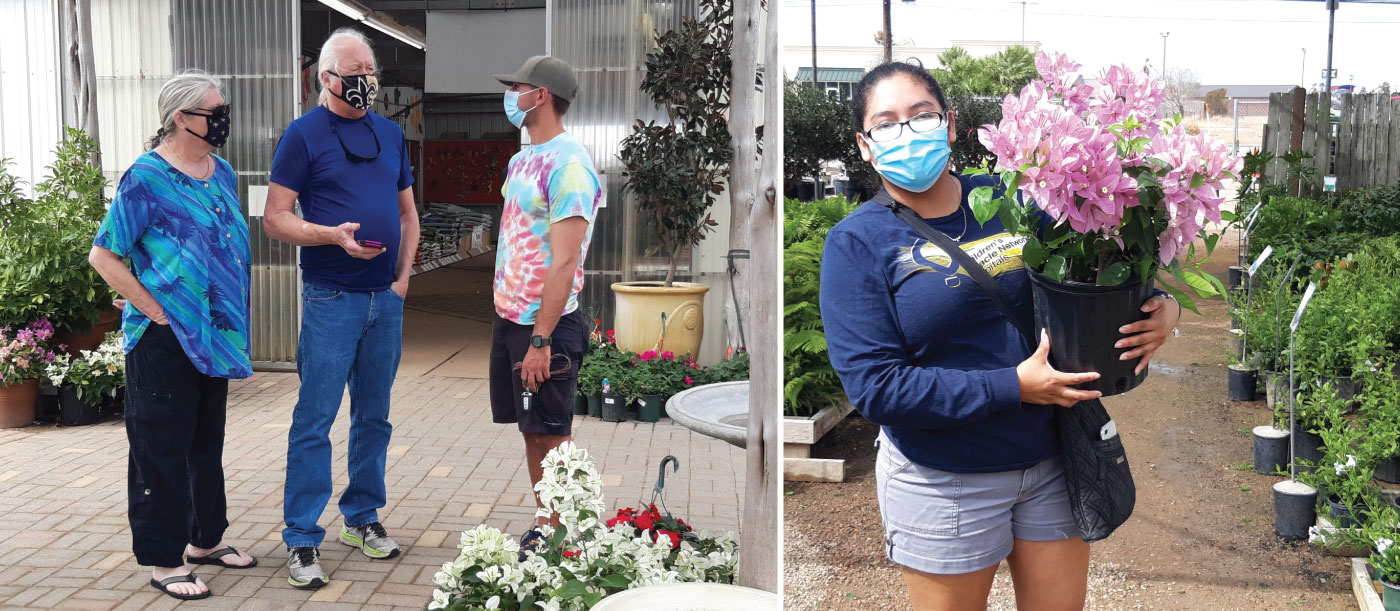Our first reaction to make it all better is to water our grass and plants. Do not water unless the ground is close to dry. Watering damaged plants will encourage fungal and bacterial growth, which we want to avoid. Stick your finger in the soil and check for moisture. If it is moist, do not water yet.
You can mow your grass if it is taller and needs to be mowed. Place your mower setting one setting lower; do not cut too short. Cutting too short will add stress to grass that’s already stressed from the freeze.
Do not fertilize your lawn until it is greened up and actively growing. That is when the grass can best absorb the fertilizer in its roots and benefit from the nutrients.
Start removing the dead/damaged portion on your plants. Some examples below are:
- If the plant is mushy (tropicals like ginger, Moses in the boat, bird of paradise) trim back to firm stem or to ground. Watch video: “Freeze Remedy: Initial Assessments”
- Plants like salvia, plumbago, firecracker plant, and flax lily, trim down to within 4” from ground.
- Plants like ixora, duranta, schefflera, hibiscus, and bougainvillea: scratch trunk and trim back to where you see green in the cambium layer of the trunk (maybe to ground).
- Philodendron – Watch video: “Freeze Remedy: How To Save Philodendrons”
- Palms – Watch video: “Freeze Remedy: Palm Trees”
- Citrus– if you scratch a branch and there is no green underneath you can remove it, but no hurry. Keep any suckers that arise from below the graft cut off, they will grow fast but produce sour fruit. If your tree is frozen all the way to the graft, fertilize with Citrus Tone now, May 1st, and September 15th to promote plenty of healthy regrowth from freeze damage.
We know it looks bad but we are here to help you get your landscape back as best we can. We are bringing in new, healthy plants from California, Florida and all over Texas. Our Texas growers learned from the 80’s freezes how to protect plants.
Thank you for your questions on our website, Facebook, Instagram, on the phone, and in person! We will continue creating videos as we see the need and as always, we’re open 7 days a week to help you with your garden!



Cheryle Flournoy says
I have two Norfolk pine that are about ten feet tall. Totally brown and shedding in high winds. They also have sap draining. How should I treat?
Cheryle Flournoy says
I have two Norfolk pine that are about ten feet tall. Totally brown and shedding in high winds. They also have sap draining. Thoughts.
Kathleen Fleming says
My Pride of Barbados looks done for. Do I cut it to the ground and hope for the best or just replace?
Charlotte says
I have cut back my Bird of Paradise and covered when watering so not to encourage fungus. I am now seeing sprouts. How long do I need to cover plant when watering?
Bevans Welder says
James,
Since Bottlebrush are dead to the ground, at what height from the ground should they be cut? Or should they be removed?
Thanks,
Bevans
James says
We are cutting them close to the ground and expecting them to re-grow from the root
Courtney MCLain Lundquist says
James,
How short should Oleanders be cut back? Should they survive?
Thank you, Courtney
James Gill says
Oleanders will likely be dead close to the ground, I have seen only one exception to this. So scratch test but be prepared to cut to 12″ to 18″ tall
Jennifer Lee says
Thank you for your response.
Jennifer Lee says
Thank you for your response.
Susan Cothran says
You replied that a Royal Poinciana is dead to the ground if it has brown sap coming out of it. Should it be cut down completely then?
James Gill says
Yes.